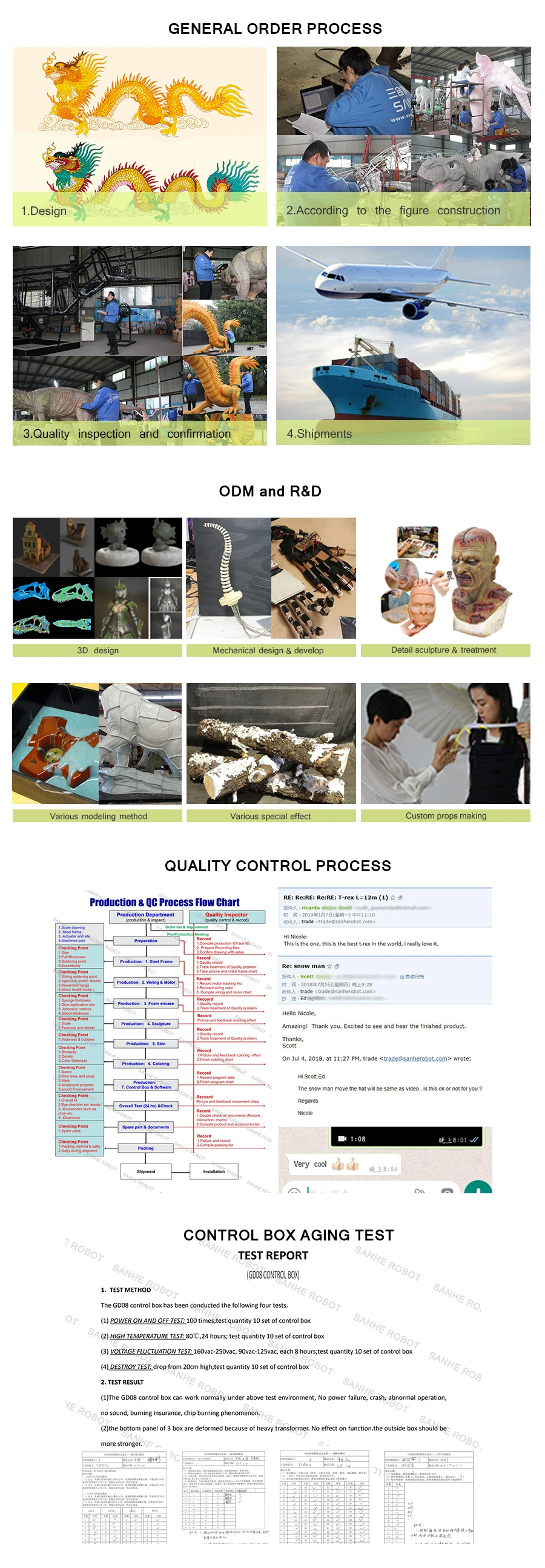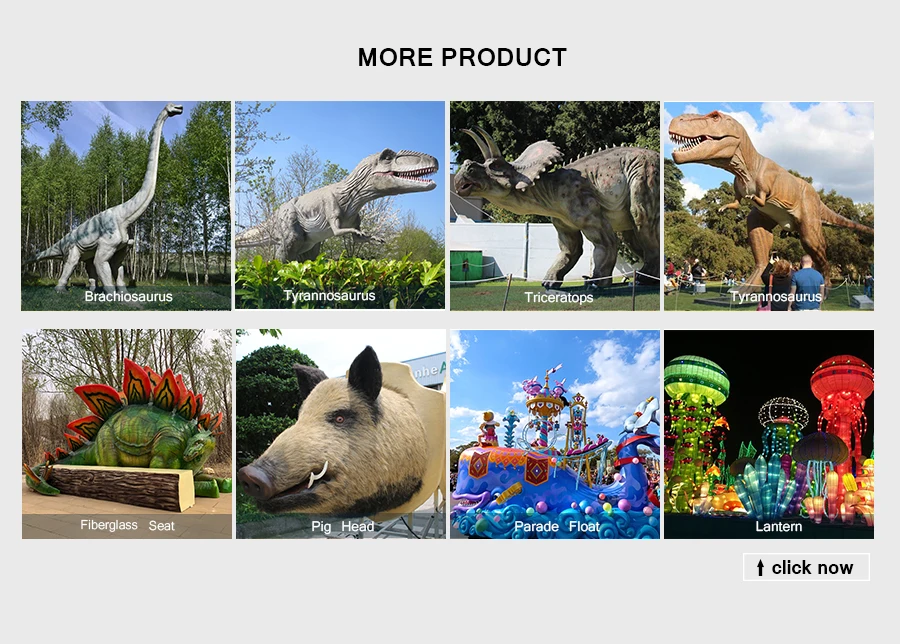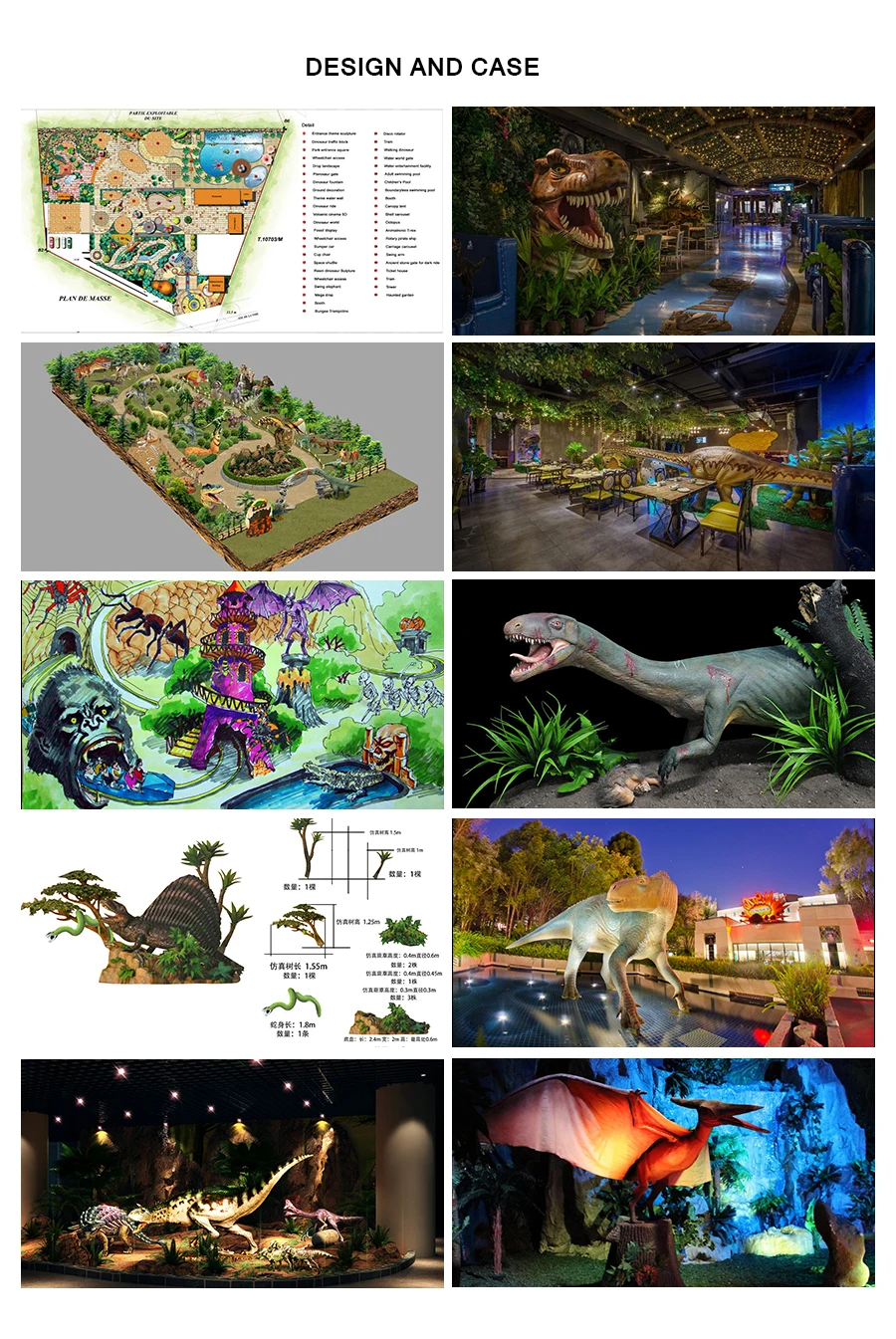Large Animal Model animatronic animal for Sale


MORE INFORMATION
| Input | AC 110/220V ,50-60HZ |
| Plug | Euro plug / British Standard / SAA / C-UL / or depends on request |
| Control mode | Automatic / Infrared / remote / coin / Button / Voice / Touch / Temperature / shooting etc |
| Waterproofing grade | IP66 |
| Working condition | Sunshine, rain, seaside, 0~50℃(32℉~82℉) |
| Optional function | Sound can be increased to 128 kindsSmoke,/ water. / bleed / smell / change color / change lights / LED screen etc interactive(Location tracking) / conversine(currently only Chinese) |
AFTER-SALE SERVICE
| Service | Need be cut for shipping,fwill provide a detailed installation manual. |
| Warranty |
We provide 2 years warranty for all of our antrimatronic models,
the warranty pieriod starts
from freight arrives at destination port. Our warranty covers motor,
reducer, control box, etc. |






 science museum exhibits robots zoo exhibition playground equipment outdoor animal playground equipment lifelike animal model outdoor playground animatronic animals silicone animal statue theme park robotic animal life size animal model animatronics model life size artificial animal zoo park animatronic animal life size animal animated life size animals life size animal sculptures for playground
Animatronic animal life-size animal lifelike animal theme park live animals
The African buffalo or Cape buffalo (Syncerus caffer) is a large sub-Saharan African bovine. Syncerus caffer caffer, the Cape buffalo, is the typical subspecies, and the largest one, found in Southern and East Africa. S. c. nanus (the forest buffalo) is the smallest subspecies, common in forest areas of Central and West Africa, while S. c. brachyceros is in West Africa and S. c. aequinoctialis is in the savannas of East Africa. The adult African buffalo's horns are its characteristic feature: they have fused bases, forming a continuous bone shield across the top of the head referred to as a "boss". It is widely regarded as one of the most dangerous animals on the African continent, and according to some estimates[citation needed] it gores, tramples, and kills over 200 people every year.
The African buffalo is not an ancestor of domestic cattle and is only distantly related to other larger bovines. Its unpredictable temperament may have been part of the reason that the African buffalo has never been domesticated, unlike its Asian counterpart, the water buffalo. African buffaloes have few non-human predators aside from lions and large crocodiles. As a member of the big five game, the Cape buffalo is a sought-after trophy in hunting
The African buffalo is a very robust species. Its shoulder height can range from 1.0 to 1.7 m (3.3 to 5.6 ft) and its head-and-body length can range from 1.7 to 3.4 m (5.6 to 11.2 ft). The tail can range from 70 to 110 cm (28 to 43 in) long. Compared with other large bovids, it has a long but stocky body (the body length can exceed the wild water buffalo, which is heavier and taller) and short but thickset legs, resulting in a relatively short standing height. Savannah-type buffaloes weigh 500 to 1,000 kg (1,100 to 2,200 lb), with males normally larger than females, reaching the upper weight range. In comparison, forest-type buffaloes, at 250 to 450 kg (600 to 1,000 lb), are only half that size. Its head is carried low; its top is located below the backline. The front hooves of the buffalo are wider than the rear, which is associated with the need to support the weight of the front part of the body, which is heavier and more powerful than the back
science museum exhibits robots zoo exhibition playground equipment outdoor animal playground equipment lifelike animal model outdoor playground animatronic animals silicone animal statue theme park robotic animal life size animal model animatronics model life size artificial animal zoo park animatronic animal life size animal animated life size animals life size animal sculptures for playground
Animatronic animal life-size animal lifelike animal theme park live animals
The African buffalo or Cape buffalo (Syncerus caffer) is a large sub-Saharan African bovine. Syncerus caffer caffer, the Cape buffalo, is the typical subspecies, and the largest one, found in Southern and East Africa. S. c. nanus (the forest buffalo) is the smallest subspecies, common in forest areas of Central and West Africa, while S. c. brachyceros is in West Africa and S. c. aequinoctialis is in the savannas of East Africa. The adult African buffalo's horns are its characteristic feature: they have fused bases, forming a continuous bone shield across the top of the head referred to as a "boss". It is widely regarded as one of the most dangerous animals on the African continent, and according to some estimates[citation needed] it gores, tramples, and kills over 200 people every year.
The African buffalo is not an ancestor of domestic cattle and is only distantly related to other larger bovines. Its unpredictable temperament may have been part of the reason that the African buffalo has never been domesticated, unlike its Asian counterpart, the water buffalo. African buffaloes have few non-human predators aside from lions and large crocodiles. As a member of the big five game, the Cape buffalo is a sought-after trophy in hunting
The African buffalo is a very robust species. Its shoulder height can range from 1.0 to 1.7 m (3.3 to 5.6 ft) and its head-and-body length can range from 1.7 to 3.4 m (5.6 to 11.2 ft). The tail can range from 70 to 110 cm (28 to 43 in) long. Compared with other large bovids, it has a long but stocky body (the body length can exceed the wild water buffalo, which is heavier and taller) and short but thickset legs, resulting in a relatively short standing height. Savannah-type buffaloes weigh 500 to 1,000 kg (1,100 to 2,200 lb), with males normally larger than females, reaching the upper weight range. In comparison, forest-type buffaloes, at 250 to 450 kg (600 to 1,000 lb), are only half that size. Its head is carried low; its top is located below the backline. The front hooves of the buffalo are wider than the rear, which is associated with the need to support the weight of the front part of the body, which is heavier and more powerful than the back

+86-813-2104677

info@sanherobot.com

+86-13990010824

No.13 Huixin Road, Yantan Town, Yantan District, Zigong City, Sichuan Province, China